Symptoms similar to dry skin:
• Winter dry skin • Xeroderma • Dry skin
Dry skin, medically known as dry skin or xeroderma, is usually caused by environmental factors, although dry skin can also lead to some of the most common skin conditions. An inherited skin condition known as ichthyosis, although very rare, can also cause flaking and dry skin. Even systemic conditions (conditions that affect the entire body) can lead to dry skin. One example is hypothyroidism, which reduces the activity of the glands that produce skin secretions. Some medications, including skin retinoids and some antihistamines and diuretics, can cause dry skin as a side effect.
Dry skin can be associated with symptoms including flaking, itching, dullness, redness, pain, and cracked skin.
Dry skin is treated with moisturizing creams and lotions. If inflammatory skin conditions are associated with dry skin, treatment is directed at the underlying condition.
Diseases that cause dry skin
• Atopic dermatitis
• Dandruff (seborrhea)
• Dehydration
• Diabetes
• Eczema
• Hypothyroidism (especially with hypothyroidism, the skin on the elbows peels)
• pilaris, keratosis pilaris
• Psoriasis
• Sunburn (sun poisoning)
Possible causes of dry skin
• Aging
• Bathing in hot water
• Contact dermatitis
• Frequent washing
• Harsh skin scrubber
• Harsh Soap and Personal Care
• Large chlorinated pools and hot tubs
• Ichthyosis vulgaris
• Low humidity
• Malnutrition
• Medicines Side effects
• Neurodermatitis (lichen Simplex Chronicus)
• Vitamin A deficiency
• Weather and seasonal factors (skin is usually dry in winter conditions)
Peeling skin - an excess of dead epidermal cells that arise as a result of disruption of the processes of keratinization and rejection.
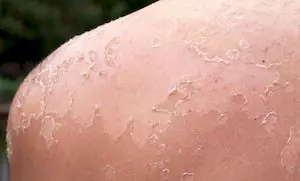
The process of renewal of the epidermal layer of skin occurs throughout a person’s life. It is natural and healthy people do not notice its progress. But sometimes a malfunction of the sebaceous glands in tandem with metabolic disorders in cellular structures is accompanied by increased dryness of the skin. As a result of this, the process of scale rejection becomes visible and passes with the appearance of itching and various rashes. This condition most often indicates the development of skin pathology or disease of internal organs.
The skin is peeling - there are reasons to be afraid
The main cause of peeling skin on the back is associated with the development of pathological processes on the surface of the epidermis (upper layer of skin). In addition, there are a number of factors that provoke increased rejection of scaly plates. According to the size of the exfoliating scales, the process has the following classification:
- large-lamellar (erythroderma and lupus);
- lamellar, most often observed in patients with psoriasis and allergies;
- pityriasis, can be found during a visual examination of patients with rubrophytosis or lichen.
There are quite a lot of diseases in which the clinical picture is accompanied by the symptom of peeling of the skin on the back:
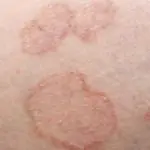
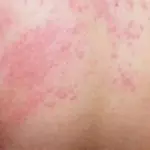
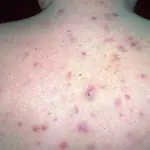
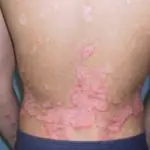
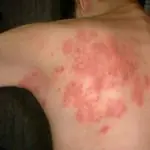

Allergy
Penetration of the allergen causes detachment of small plates, which are accompanied by severe itching.
Allergens for humans can be:
- perfumes, cosmetics and household chemicals;
- insect, arthropod or snake bites;
- chemical compounds of heavy metals (nickel, cast iron, steel);
- pharmacological agents (especially antibacterial agents or drugs with natural extracts and extracts);
- any food products, especially fruits, berries and citrus fruits, as well as food colorings, preservatives and stabilizers that are used in food production to extend shelf life.
Pityriasis rosea
Initially, a small red plaque appears, on the surface of which there is an increased rejection of the scales of the epidermal layer. If appropriate therapy is not performed, the number of spots increases. Unlike other processes, the skin does not itch.
Erythema
With this disease, symptoms of peeling and severe itching occur simultaneously with an increase in body temperature.
Ichthyosis
Psoriasis
A feature of this pathology is the active rejection of cells of the old epidermis. Peeling is accompanied by a feeling of itching and may bleed.
Dermatitis
Peeling may be accompanied by the appearance of rashes in the form of red spots with a burning and itching sensation.
Vitamin deficiency and lack of micro and macroelements
The main feature of such conditions is that the use of local cosmetics and moisturizers does not have a positive effect. To reduce peeling, it is necessary to compensate for the lack of vitamins and normalize the intake of essential minerals (calcium, potassium, zinc, magnesium) into the body.
Other factors
If the skin on your back is peeling, you should think about the impact of other factors that are not associated with pathologies:
- Washing in a sauna or bath using hot water. In this case, the skin gets used to the high temperature, but at the same time the body needs frequent renewal of epidermal cells.
- Increased exposure to external factors when washing in a bathhouse: using a hard sponge or broom, which causes mechanical damage to the skin.
- Changes in climatic conditions (heat, cold, wind).
- Long-term use of cream with a moisturizing effect.
- Age-related changes, the onset of menopause in women.
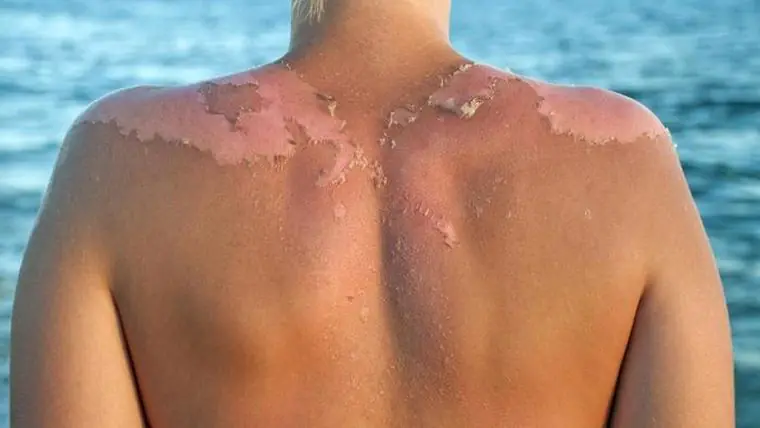
consequences of a strong tan
Itching is another skin quirk
The biomechanism of itching has not yet been sufficiently studied, but most experts consider it as a violation of tactile perception associated with a narrowing of the lumen of capillary vessels. As a result, skin receptors are irritated, which leads to itching. If the skin is rough and itchy on the back, this is due to the increased content of the following components:
- A sharp release of histamine and acetylcholine (substances that irritate nerve receptors) into the systemic circulation. This occurs as a defensive reaction to the penetration of foreign protein inclusions.
- Bile acid. The phenomenon of cholestasis (stagnation of bile) leads to disruption of the functionality of the biliary tract, and, as a result, excess bile acid enters the systemic circulation and is transported throughout the body. Penetrating the skin surface, a symptom of itching appears.
- Slags of nitrogenous compounds. They arise as a result of kidney dysfunction; their transport to the epidermis causes the body to itch.
Don't forget to visit the doctor
The appearance of the symptoms discussed should be accompanied by a visit to a medical facility for a consultation with a doctor. If this is an allergic process, you need to make an appointment with an allergist. In case of skin pathology, a dermatologist will help to establish the correct diagnosis and prescribe complex therapy. If the clinical picture develops due to the penetration of an infectious pathogen, then it is best to consult an infectious disease specialist.
The combined appearance of the following symptoms necessitates an urgent medical examination to establish a diagnosis and choose treatment tactics:
- peeling spreads to the lower and upper limbs;
- the appearance of pustules and pustular rashes, after opening of which a wet surface remains;
- how infectious diseases of fungal or bacterial etiology appear as a consequence of scratching;
- peeling of the back occurs for a long time with the appearance of a feeling of itching, especially in the pre-dawn hours.
Possible negative consequences of increased detachment of scales in the back area:
- If this process appears under the influence of an allergen and is accompanied by the appearance of red spots, then there is a possibility of developing anaphylactic shock or Quincke's edema. These reactions require immediate treatment, otherwise respiratory failure may occur, followed by death.
- When the rash is inflammatory in nature, the lack of proper therapy increases the chance of the disease becoming chronic.
- Peeling and itching create a dangerous tandem, which is manifested by the penetration of infectious microflora through scratching areas. In this case, fungal, staphylococcal or any other infection causes negative consequences, and the treatment process requires a long time and additional material costs.
- Prolonged exfoliation of scales can cause the appearance of pigment spots or pustules that are difficult to treat. This does not pose a threat to life, but causes a cosmetic defect (especially for the fair sex).
- If peeling is not associated with skin manifestations, but is a consequence of pathological processes in internal organs, then it is unacceptable to ignore this condition. This can lead to the progression of the disease and transition to a chronic form.
Treatment Options
If your back itches without or with a rash, an accurate diagnosis is first made. After the cause of peeling on the back and shoulder girdle has been identified, pharmacological drugs are prescribed. They are used depending on the disease.
In each individual case, appropriate medications are prescribed.
Medicines that prevent increased histamine synthesis:
These tablet forms are fast-acting, but should only be prescribed by a doctor, since first-generation drugs have a hypnotic effect. Doctors try to prescribe antihistamines more often without drowsiness.
Ointments for increased detachment of scales of the epidermal layer of skin:
- Elokom is effective against the appearance of psoriatic rashes, dermatitis and lichen. Eliminates the effects of allergies.
- Gistan N is able to quickly relieve the severity of the inflammatory process and neutralize the effect of allergens.
- D-Panthenol increases the regeneration of epidermal cells, promotes rapid healing of scratches, eliminating the symptom of maceration (the appearance of a weeping surface).
Medicines for the development of candida fungus:
- Miconazole can be prescribed if the fungal microflora is localized at any location. To maintain the therapeutic concentration, the ointment should be applied twice a day.
- Exoderil is able to provide positive dynamics even in advanced cases with various forms of candidiasis.
Adrenal cortex preparations:
They have a powerful anti-inflammatory effect, despite the fact that they are used in short courses (no more than 2 weeks).
The use of mesotherapy involves intradermal administration of injection solutions:
- beneficial amino acids;
- high in vitamins;
- a large amount of micro and macroelements.
Any symptoms that are not natural for a healthy person should be considered as a potential threat to the body. Therefore, you should not put off visiting a doctor who will tell you why your back is itching and how to get rid of it.
Self-treatment in the absence of knowledge in medicine allows you to get rid of the symptom for a short time, which does not lead to eliminating the main cause of the disease. This is dangerous, as time may be lost, and the course of the disease will move to the next stage, which is much more difficult to cure.
Skin is a kind of barometer of overall health. Any imbalance manifests itself in the form of peeling, redness or rashes. Spots on the back that cause discomfort may not only be a consequence of the use of low-quality cosmetics. They are often the main symptom of fungal skin diseases that require complex treatment.
Causes of peeling on the back
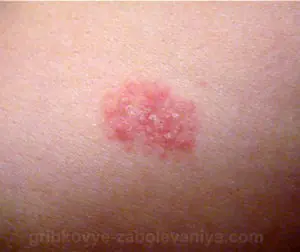
Ringworm on the back photo
Different types of lichen are a whole group of diseases caused by pathogenic fungi of several types. According to medical statistics, more than half of people of different ages encounter them. Many types of pathogens are transmitted from a sick person through contact or use of his personal belongings. The smallest particles with spores get on the skin when visiting a swimming pool, bathhouse or massage room, when being treated by a cosmetologist or through bed linen.
In most cases, a healthy body easily copes with the infection, preventing fungi from growing and becoming active. Ringworm and many types of lichen are more likely to occur in people with reduced immunity. At risk are adults and children who:
- have chronic forms of diseases of the intestines, thyroid gland or the entire endocrine system;
- suffered from influenza or acute respiratory viral infection;
- have immunodeficiency due to HIV, tuberculosis or hepatitis;
- are in a stressful situation or overexertion.
Ringworm can appear in a healthy person if there is a small rash on the back, microcracks invisible to the eye. They are an open gate for infection and create ideal conditions for inflammation.
There are several types of dermatomycosis, in which the skin on the back peels:
They have similar symptoms, but are caused by different types of fungi. Therefore, you cannot do without high-quality diagnostics and consultation with a dermatologist.
The main symptoms of depriving Zhiber
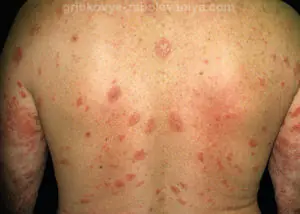
Pink lichen of Zhiber on the back
Pityriasis rosea gets its name from the characteristic color of the spots that cover the patient’s back in large numbers. The rounded formations with a diameter of up to 5 centimeters can be very itchy, causing the skin on the back to itch. More than a quarter of patients experience severe tingling to the point of pain. In addition, a person experiences:
- small rashes on the back;
- a combination of large and small spots at the same time.
Pityriasis rosea is uncommon in children and older adults. Doctors cannot reliably identify the fungus that causes it. Once the immune system is strengthened, it goes away well with minimal treatment. Patients are recommended to lubricate spots on the back with iodine solution, Clotrimazole or Miramistin, and monitor the hygiene and dryness of the dermis. Antiallergic drugs will help reduce the burning sensation: Loratadine, Suprastin or Zodak.
Symptoms of pityriasis versicolor

Pityriasis versicolor on the back photo
An unpleasant fungal disease is a common form of mycosis. It is classified as keratomycosis, which causes specific peeling of the skin. Pityriasis versicolor is caused by fungi of the genus Malassezia furfur or Pityrosporum ovale. Main symptoms of the disease:
- large inflamed areas with jagged, torn edges;
- whitish spots;
- peeling of the surface in the form of large grains.
This form of mycosis is often accompanied by a secondary bacterial infection, causing itching, tingling and more serious complications. The lesions can merge into large areas, become dark in color and contrast with the basic tone of the skin on the back.
Pityriasis versicolor requires long-term treatment with special creams. You can use antifungal compounds such as:
Antiallergic drugs in drops or tablets will help reduce discomfort if the skin on your back is itchy.
Diagnosis of seborrheic dermatitis
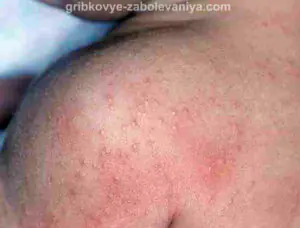
Seborrhea on the back photo
This disease of the epidermis is chronic and often recurs with fungal inflammation. Seborrheic dermatitis is caused by pathogenic pathogens such as Pityrosporum ovale, which affects more than 90% of all inhabitants of the planet. The main factor in the appearance of large areas on the back is the tendency of this part of the body to sweat and secrete sebaceous fat during adolescence.
The following symptoms help a specialist diagnose the disease:
- inflamed spots with small red rashes;
- peeling, more like scales;
- severe painful itching.
If the skin on your back is peeling due to seborrheic dermatitis, it can be treated with topical antifungal creams: Nystatin, Nizoral or Ketodin. Elokom hormonal ointment and vitamin complexes with nicotinic acid have a good effect. A special diet, quitting smoking and reducing alcohol intake are of great importance.
Features of dermatomycosis in children
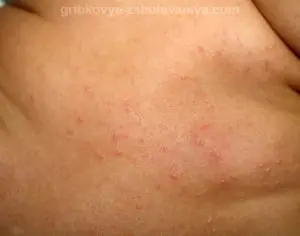
Allergic rash on the back of a child
Often such diseases occur in young children. For them, the main sources of fungal infection are family members and peers. The problem is caused by the use of shared toys, personal belongings and contact with sick animals. Most often, children with dysbacteriosis, complications after staphylococcal infection or viral diseases get sick. Seborrheic dermatitis or pityriasis rosea can appear due to a stressful environment in the family or school.
If the skin on the back of a preschool child is peeling, parents should rule out allergies to sweets and foods, or overheating from wearing synthetic things. Treatment should be carried out under the supervision of a doctor, who selects the drug based on weight and other health problems.
At the initial stage, it is enough to use a cream or ointment:
For the treatment of children, Griseofulvin is used with caution, which can cause allergic reactions and increase peeling on the back. To prevent the baby from being bothered by itching, be sure to include antihistamines in the treatment plan: Claritin, Zyrtec or Telfast. To completely get rid of lichen, it is necessary to strengthen the child’s body with vitamins and a balanced diet, and create a comfortable environment.
Manifestation of dermatomycosis during pregnancy

Peeling skin on the back of a pregnant woman
Peeling skin during pregnancy is a common reason for visiting a dermatologist. Carrying a baby greatly weakens fragile women's health and reduces immunity. Typically, exacerbation of pink or pityriasis versicolor occurs after the second trimester. This is due to changes in hormonal levels, increased nervousness and fatigue.
A particular problem when treating spots on the back of a pregnant woman is the limited choice of drugs. Many antifungal creams should not be used in the first weeks so as not to cause harm during the formation of the fetus.
It is allowed to treat flaky areas with such compounds as:
Pityriasis rosea or pityriasis versicolor will not harm the fetus. But during pregnancy, it is necessary to completely cure the fungus before childbirth, so as not to infect the baby.
Seborrheic dermatitis, pink or pityriasis versicolor are often complicated by relapse. Therefore, it is necessary to monitor your health, eat high-quality healthy foods and strengthen the immune system through exercise.
Doctors warn! Shocking statistics - it has been established that more than 74% of skin diseases are a sign of parasite infection (Accarida, Giardia, Toxocara). Worms cause enormous harm to the body, and the first to suffer is our immune system, which should protect the body from various diseases. The head of the Institute of Parasitology shared the secret of how to quickly get rid of them and cleanse your skin, it turns out that’s enough. Read more .



